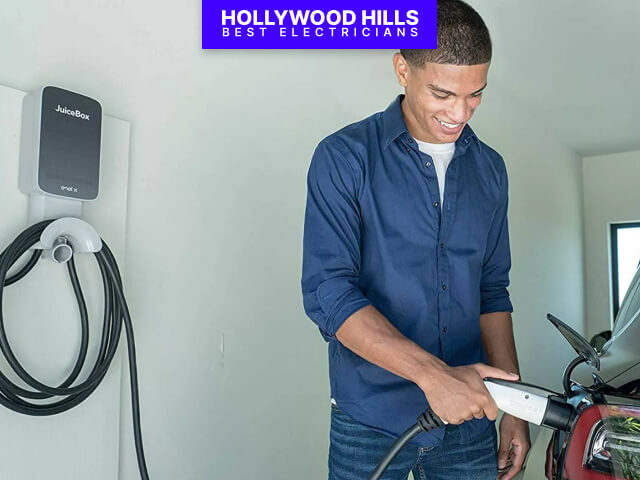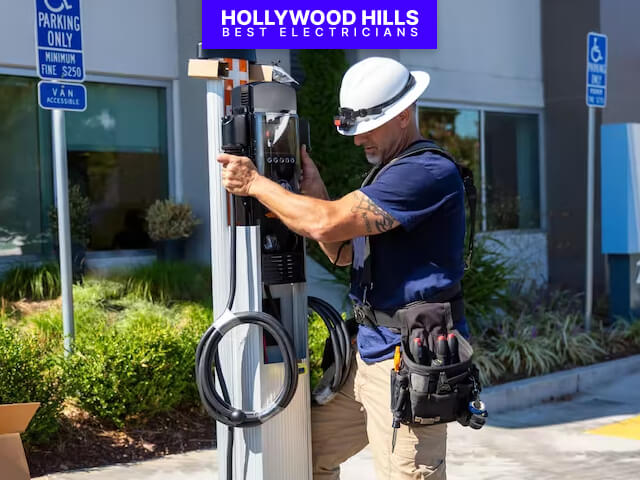The first thing that comes to mind when an electric vehicle charging station keeps tripping a circuit breaker is that something is wrong with the EVSE (electric vehicle supply equipment). But the reality is that there are many other factors besides the EV charging station itself that could be responsible.
If you want to have a quick fix, you can always call Hollywood Hills Best Electricians. We are masters of EV Charger Installation and repair, so you’ll be in good hands.
Nevertheless, here are 4 common causes of this problem:
- The Charging Station is too far away from the electrical panel.
The best way to determine if your charging station is too far away from the electrical panel is to measure the distance. If you are using a 240-volt charger and you need more than 100 feet of cable, then it could be tripping a circuit breaker because it’s too far away from the electrical panel. The maximum length of cable for a 240-volt charger should be no more than 50 feet.
The solution for this is to get closer to the chagrin station. Make sure that the charger itself is also connected properly so that it’ll not cause problems at all.
- The electrical panel circuit breaker is overloaded.
First, check the circuit breaker. If it’s tripped, that could be a sign that there’s too much electricity going through your home or business, and you’ll need to reset it.
The solution is to turn off the main power switch for your building, house, or the structure wherein the EV charger is located by flipping off the power at its source (typically a wall outlet) or at an electrical box located somewhere near where you’re standing. This will ensure that no more electricity flows through your circuit breaker and into your home/business if it happens to trip again.
Look at both sides of each of the two screws holding down each side of each terminal on your tripped breaker. One side will have one black wire connected to it, while another has two black wires connected together with may also include either red or green ones as well depending on how many breakers are installed within this panel.
- There are other appliances using power on the same circuit.
If you’re not sure whether or not there are other appliances on the same circuit, you can check. First, plug your EV charger into any outlet in your home and turn on the breaker that powers that outlet. Then, press the power button on your charger to see if anything lights up. If it does, then there are appliances plugged into outlets powered by this breaker as well!
This can be avoided by installing a new circuit breaker in order to supply power solely for your EV charging station—or simply by unplugging some of these other devices when charging at home (though this may not always be possible).
- Weak or loose electrical connections in the electric vehicle charging station.
Electric Vehicle (EV) charging stations are designed to convert a 240v AC outlet into either a single phase 120/208 volt 400 amp circuit or a three-phase 208/480 volt 400 amp circuit.
To remedy this, just simply tighten the electrical connections in the vehicle charging station properly. Make sure not to tighten it too much nor too loosely.
Breaker Keeps Tripping While EV Charging? Follow These Steps to Learn How to Troubleshoot

If your breaker keeps tripping while charging your electric vehicle, you may have to do some electrical work to resolve the issue. This is a common problem with many EV owners and can be frustrating.
However, there are some simple steps that can help you get back on track again without having to hire an electrician or spend too much time troubleshooting. In this article, we’ll go over some of these steps so that you can learn how to troubleshoot this issue if it ever happens in your home.
- Check the Safety Features on Your Home Electrical System
If you’ve already tried turning off your breaker and waiting to see if the issue persists, it’s time to move on to troubleshooting. This process will vary depending on your home’s electrical setup and whether or not you have a dedicated EV charging station. You may need to check the circuit breakers, fuses, wires, and outlets in your home’s main electrical panel or subpanel (if applicable).
To get started with troubleshooting:
- Check the circuit breaker box(es) for tripped breakers. If any of them are tripped, flip them back on—but don’t plug anything else into that circuit until you’re sure it’s safe.
- Look at each individual breaker in turn in order to determine which one is responsible for powering up your EV charger or charging station (as opposed to other lights/appliances).
- Then flip this particular breaker back on while leaving all others off. This way, we can isolate our problem area down from multiple possibilities into just one culprit—the faulty device itself!
- Look for Other Chargers Located Nearby
If you have a charger installed in your home or garage, make sure that power is on in the house or garage. If you have an external charger, check to see if there are other chargers located nearby. This could be at work, at a friend’s house, or even just down the street. This will help rule out any faulty wiring.
- Ensure the Charging Cord is Okay
Before you get started, you’ll want to make sure there’s no damage to the cord itself. If it has frayed, or there are any signs of damage to the plug, car charger end, or wall outlet (e.g., arcing or fire), then find a new charging cord and/or adapter before proceeding.
Next, check for damage to your extension cord by unplugging it and looking for cracks in its insulation at either end of the cable and along its length where it may be bent.
For example: if your extension cord is coiled up around an object like a chair leg or table leg when plugged into an outlet, this could cause strain on those places where connections are being created within the extension cord itself. This means that these parts might eventually break off entirely over time!
Finally, check all the components—wall box (if applicable), car charger end adapter/charging port connector pins along with your charging point connector pins—for any visible abnormalities such as bent pins, etc.
- Know About Overloaded Circuits
Knowing the basics of how a circuit breaker works can help you identify when one fails to do its job.
In most cases, a circuit breaker is meant to trip when the current in the circuit exceeds a certain level. This is because there are only so many amps of power that each appliance can safely use on a given circuit. If you try to use more than this amount at once, it overloads the circuit and causes the breaker to trip off.
If your EV charger has repeatedly been tripping for no apparent reason (or if you suspect this is happening), first check that it’s actually hooked up correctly with no loose wires or other problems before assuming it’s a problem with your charger itself. If all seems well there, then consider whether or not there might be something else causing too much current demand in your home at once—it could also be an overloaded outlet!
If you’re still experiencing issues with your breaker tripping while charging your electric vehicle, it may be time to call an electrician.
Give Hollywood Hills Best Electricians a call if you are still experiencing breaker tripping while changing your electrical vehicle. We promise that your EV charger or charging system will be fixed right away.

